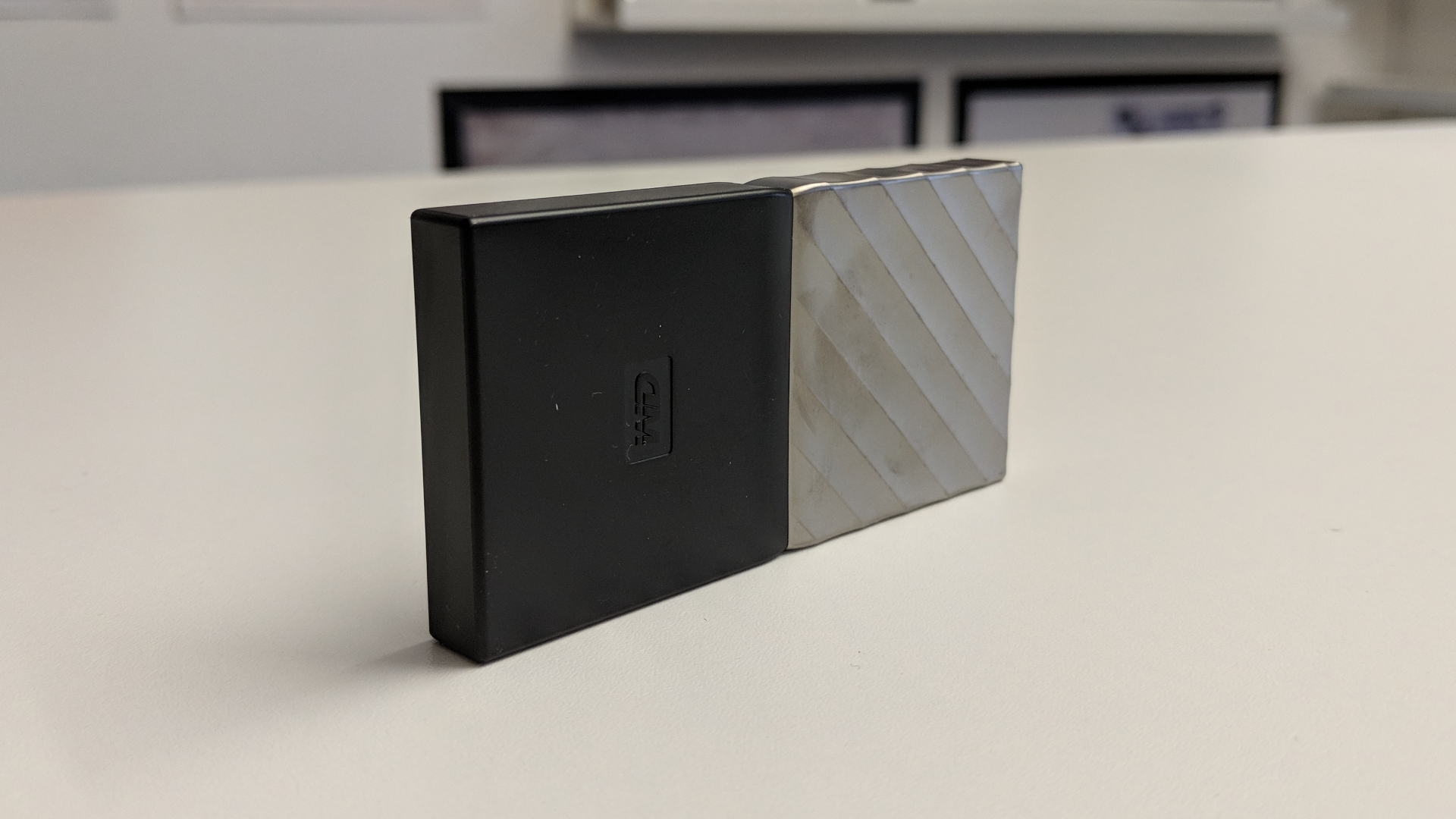TechRadar Verdict
The My Passport fulfills WD’s ambition to provide a complete portfolio of SSDs. This particular model delivers the goods, albeit without excelling either from a performance or from a value-for-money point of view.
Pros
- +
Nice design
- +
Great performance
- +
USB Type-C
Cons
- -
Expensive for what it offers
- -
Maximum 1TB capacity
Why you can trust TechRadar
External drives aren’t exactly the sexiest devices on your desk, but thanks to solid-state memory, engineers are now able to cut the size of storage products down – while still being able to innovate when it comes to form factors.
The My Passport SSD is WD’s first external SSD and has been designed to be small enough to fit in your front pocket, while still being big enough to not get lost among the clutter in your jean pocket.
Available in 256GB, 512GB and 1TB capacities, it covers the most popular varieties and sits neatly in WD’s portfolio with the ruggedised SanDisk devices and more business-focused G-Technology GDrive products, both of which are notably more expensive.

Design
We reviewed the 256GB model which comes with a USB Type-C (USB 3.1 Type 2) connector, meaning that it can hit 10Gbps if connected to a compatible device. It is small, but not quite as streamlined as some of its competitors. At 90 x 45 x 10mm and weighing 120g, it looks like a small chocolate bar, with half of the device’s body clad in plastic matte black and the other half sporting a ridged gunmetal finish.
The product looks and feels solid but unlike, say, the Adata SE730H, it is not IP68-rated; so don’t drop it in water. It will take a few tumbles though, being shock-resistant up to 2m, and it is backed by a longer-than-average three-year warranty.

Other than the usual logos and small print (barcode, serial numbers etc), the only notable feature is a USB Type-C connector located at the end of the SSD; there are no status lights.
Connect it using the bundled 45cm cable and you’re ready to go, as the My Passport is bus-powered, thereby eliminating the need for an external power supply unit. You can use the bundled Type-A adaptor if you don’t have a Type-C connector on your host device.
Usage and performance
As expected, there’s a fairly robust set of software applications preloaded on the SSD under the WD Discovery umbrella. WD Backup, for example, will automatically back up files from your PC to your drive and is even compatible with Apple’s Time Machine. WD Security software will encrypt your data using 256-bit AES hardware encryption. As expected, the applications are compatible with Mac and Windows.
Here’s how the WD My Passport SSD 256GB performed in our benchmark tests:
CrystalDiskMark: 337 MBps (read); 335 MBps (write)
Atto: 403 MBps (read, 256mb); 404 MBps (write, 256mb)
Inside the case is a SanDisk drive with a 256GB capacity (the formatted capacity is 238GB). The SD8TN8U256G2000 (with X4161100 firmware) is what powers the SanDisk X400, a SATA3 2.5-inch drive that uses 15nm TLC NAND chips paired with a Marvell 88SS1074 4-channel controller.
The WD My Passport carries the same technology that powers the X400: nCache 2.0, DataGuard and LDPC error correction, with an 80TBW endurance. The drive is formatted as a single exFAT partition for compatibility with Windows and macOS operating systems.
Overall, it is an average performer, falling short of the numbers hit by Samsung, Adata or the GDrive, which in the latter case, is quite puzzling given that they use the same components.

The competition
The My Passport costs £169.99 ($240) for the 500GB version (Amazon) and £307.57 ($435) for the 1TB model (Amazon), significantly more expensive than the G-Drive, despite probably using the same components, as mentioned. The 256GB model we tested retails for £94 ($130).
The G-Technology G-Drive (1TB model) from parent company Western Digital costs £192 (Amazon) – that’s around $270. That translates into a per GB cost of 19.2p, making the G-Drive the cheapest external SSD on the market. It is the least portable of the solid-state drives around but its sheer value for money is unquestionable.
The Samsung T5, in contrast, sells for £164.36 (Amazon) – around $230 – for the 500GB version, with the 1TB model selling for a whopping £314.36 (Amazon) – around $440 – a significant price premium. Samsung’s external SSDs are far smaller but that’s about it.
Adata’s SD700, whilst more expensive and slightly slower, is more portable and is IP68-rated, great for the niche that it is targeting. At £170 ($240) for the 512GB model (Amazon), it is an attractive option for those who require a sturdier solution for their storage needs.

Final verdict
The WD My Passport delivered some solid performance and is competitive price-wise with Samsung and Adata’s offerings, but is far more expensive than G-Drive’s bigger model. Although the latter was launched nearly a year ago, it is still very much competitive with rivals that were released more recently.
It would be great if WD could produce an even smaller version of this drive and introduce a 2TB size to compete with Samsung. Making it IP68-rated would be a nice little addition but that’s unlikely to happen as it would overlap with WD’s other sub-brand, the SanDisk X-series products.
- We’ve picked out the best portable drives for your PC or Mac

Désiré has been musing and writing about technology during a career spanning four decades. He dabbled in website builders and web hosting when DHTML and frames were in vogue and started narrating about the impact of technology on society just before the start of the Y2K hysteria at the turn of the last millennium.
